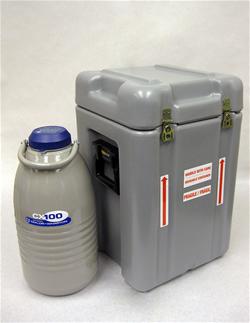Dry Nitrogen Shippers
 Liquid nitrogen is cryogenic, with a boiling point of -321 F (-196 C). Cryogenic means related to very low temperatures. Liquid nitrogen is extremely cold and liquefied under high pressure. Thus, the major hazards of liquid nitrogen include both physical and health hazards. Physical hazards include pressure build-up, fire and explosion. Health hazards include severe frostbite and asphyxiation. Because of these factors, the Department of Transportation (DOT) regulates liquid nitrogen and other cryogenic liquids as hazardous materials during transport. If you need to ship liquid nitrogen, you must have specialized training. One way to avoid this requirement is to use a dry dewar, otherwise known as a “dry shipper”. Liquid nitrogen is cryogenic, with a boiling point of -321 F (-196 C). Cryogenic means related to very low temperatures. Liquid nitrogen is extremely cold and liquefied under high pressure. Thus, the major hazards of liquid nitrogen include both physical and health hazards. Physical hazards include pressure build-up, fire and explosion. Health hazards include severe frostbite and asphyxiation. Because of these factors, the Department of Transportation (DOT) regulates liquid nitrogen and other cryogenic liquids as hazardous materials during transport. If you need to ship liquid nitrogen, you must have specialized training. One way to avoid this requirement is to use a dry dewar, otherwise known as a “dry shipper”.
Dry shippers do not contain free liquid nitrogen, but are capable of keeping materials at required temperatures for up to 24 hours. When properly prepared, dry shippers themselves are not considered DOT hazardous materials, which allows for more flexibility and cost savings. A dry shipper is properly prepared when it does not contain any free liquid nitrogen or any other regulated hazardous material, and will not allow the build-up of pressure inside the container.
Dry shipper manufacturers supply instructions for filling them, but some general safe practices include:
-
Wear special cryogen gloves, safety goggles, full face shield, impervious apron or coat, long pants, and high topped shoes.Gloves must be impervious and sufficiently large to be readily removed should a cryogen be spilled. Watches, rings, and other jewelry should NOT be worn.
-
Objects that are in contact with cryogenic liquid must be handled with tongs or proper gloves.
-
Work areas must be well ventilated.
-
Transfers or pouring of all cryogenic liquids should be done very slowly to minimize boiling and splashing.
-
Once filled, set the dry shipper aside for the period of time specified by the manufacturer. This allows adequate time for the liquid nitrogen to saturate into the absorbent inside the shipper.
-
Preparing the dry shipper for transport requires the removal of any and all remaining free liquid nitrogen inside the container. Empty the shipper by inverting it upside down, pouring all excess liquid back into a large liquid nitrogen dewar. Do this for at least two inversions until you are sure there is no longer free liquid nitrogen remaining.
-
Stand the dry shipper upright for a period specified by the manufacturer.
-
Place the material you are shipping inside the dry shipper and replace the cap.
Again, be sure that the materials you ship in a dry dewar are not regulated as hazardous materials themselves. If so, they must be shipped in compliance with DOT regulations. Please contact EHS at 274-2005 with any of your hazardous materials management/transportation questions.
|